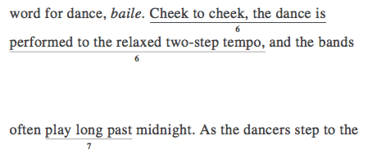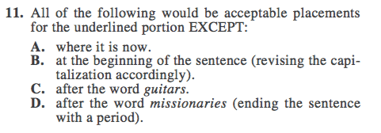
One of comedian Groucho Marx's most famous jokes involves a pachyderm and some sleepwear.
"One morning I shot an elephant in my pajamas," he says. "How he got in my pajamas I don't know!"
This joke is a play on a grammatical error called a misplaced modifier.
The modifier errors on the ACT English may not be quite as funny as Groucho's, but you still have to understand how they work. To that end, we'll be covering both the basic grammatical concepts behind faulty modifiers and how to apply that knowledge on the test:
- Key Principle: Modifiers Must Be Next to What They Modify
- Dangling Modifiers: Modifying Phrases at the Beginning of Sentences
- Misplaced Modifiers: Modifier Order Within Sentences
- ACT English Tips and and Tricks
- Practice Questions
Modifiers Must Be Next to the Thing They're Modifying
The heading says it all: the most important concept to remember when dealing with modifiers is that they need to be next to the word they're describing.
Sometimes these types of mistakes are obvious:
Robot for sale by woman with laser eyes.
Hopefully, the robot has the laser eyes, and not the woman. The sentence should be:
Robot with laser eyes for sale by woman.
However, on the ACT, this kind of error is often harder to spot. Take a look at the following sentence:
Though exhausted, it would be another hour before Zoe got to go home.
There's nothing obviously wrong with this sentence, but let's think about what it's actually saying. We start with the modifier "though exhausted." That would seem to be describing Zoe, but it's next to "it," so right now, the sentence is actually saying that "it" is exhausted, which makes no sense. We need to reorder the sentence so that the modifier is next to what it's modifying:
Though exhausted, Zoe wouldn't get to go home for another hour.
There are two main types of faulty modifiers on the ACT English section: dangling modifiers, which involve phrases at the beginning of sentences (e.g. the example about Zoe), and misplaced modifiers, which involve the order of words and phrases within sentences (e.g. the example about the robot). Don't worry about the dangling/misplaced terminology—what's important is how these errors are tested on the ACT, which we're about to cover!

This is what you end up with when you misplace modifiers. (©Dan Century)
Dangling Modifiers: Modifying Phrases at the Beginning of Sentences
When a sentence begins with a modifying phrase, the intro must be immediately followed by a comma and then the noun it's describing. Incorrect sentences of this type start with modifying phrases that describe something other than the noun immediately following the comma. For example:
Running toward the lake, the trees were swaying in the wind.
"The trees" are obviously not running towards the lake—they don't have legs.
There are two ways to correct this kind of error: you can either replace the incorrect noun (in this case "trees") with the correct one, making any changes necessary to preserve the meaning of the sentence (fix 1), or you can turn the intro phrase into a clause that includes the subject the phrase is meant to be describing (fix 2). These techniques sound more complicated than they are, so let's put them to use remedying our issue with the running trees:
Fix 1: Running toward the lake, I saw the trees swaying in the wind.
Fix 2: As I ran toward the lake, the trees were swaying in the wind.
Both versions of the sentence are equally correct. You won't be asked to choose between the two options—instead, which approach makes more sense will depend on which part of the sentence is underlined and what answer choices you're given.
Situation 1: Main Clause Underlined
If only the main clause is underlined, you'll need to pick the answer with the correct subject—what I refer to above as fix 1. For example:
Incorrect: With tears running down her cheeks, Susie’s sadness was obvious.
Correct: With tears running down her cheeks, Susie was obviously sad.
Even though the distinction may not seem important, "Susie" and "Susie's sadness" aren't actually the same, and Susie's sadness can't cry. If the second half of the sentence is underlined, the best way to correct that issue is to replace the incorrect noun "Susie's sadness" with the correct one "Susie."
Let's take a look at how this works on an ACT style question:
Initiated by a few loud teenagers, the crowd of concert goers quickly joined the heckling in order to drive the band off the stage.
A. NO CHANGE
B. in order to drive the band off stage, the crowd of concert goers quickly joined the heckling.
C. the point of the heckling, quickly joined by the crowd of concert goers, was to drive the band off stage.
D. the heckling, which the crowd of concert goers swiftly joined, was intended to drive the band off stage.
What's the problem here? That "the crowd" wasn't initiated by the teenagers, the "heckling" was. As such, "heckling" has to come immediately after the comma, no matter how tempting the other choices are. D is the correct answer.
Situation 2: Intro Phrase Underlined
On the other hand, if only the introductory phrase is underlined, you have to convert the introductory phrase into a clause that clarifies who or what is being described (fix 2). Let's examine our example about Susie from this perspective.
Incorrect: With tears running down her cheeks, Susie’s sadness was obvious.
Correct: Because there were tears running down Susie's cheeks, Susie’s sadness was obvious.
We can't alter the subject in this case, so we need to turn the prepositional phrase into a dependent clause that makes it clear that the cheeks belong to Susie.
Let's take a look at how this works in a multiple choice question from an official ACT:


As written, this sentence is saying "she" has died down, which doesn't make sense: it should be the fire. But because only the first part is underlined, we can't change "she" to "the fire," instead we have to pick an answer that makes clear that the fire is what's dying down. Clearly, F won't work, and neither does G, since it has the unclear pronoun "it."
H and J both specify that we're talking about the fire, but "with" in H doesn't make much sense here—J is the best choice since it maintains the temporal relationship (she bricks up the firebox after the fire dies down), while clarifying what exactly is dying down.
Situation 3: Both Parts Underlined
On the ACT, you may also see dangling modifiers in the context of more general sentence organization questions. In these cases, all or most of the sentence is underlined.
There's no single correct approach to these types of questions; instead, you need to rule out any answers with grammatical issues, and choose the clearest answer among the remaining options. Let's work through an example from an official ACT English section:


First we need to figure out who or what is "cheek to cheek," and the only things in this sentence with cheeks are the dancers. Thus if the sentence starts with "cheek to cheek," a noun or pronoun indicating the dancers should come immediately after. Both F and J incorrectly put other nouns in that position (though "cheek to cheek" describe how the couples dance, the dance itself isn't "cheek-to-cheek").
H switches "cheek to cheek" and "relaxed two-step tempo," which actually makes even less sense, since the latter phrase isn't a modifier (it's a noun phrase). This leaves G, which orders the modifiers logically to indicate that they describe how the couples are dancing.

You don't want your modifiers to end up like this guy—dangling. (©Tony Hisgett)
Misplaced Modifiers: Modifier Placement in Sentences
Now that we've covered how to approach questions about modifiers at the beginning of sentences, let's talk about modifier placement within sentences.
Let's revisit the key rule for modifier placement: a modifier must be next to whatever it's modifying. More specifically, single word modifiers, i.e. adverbs and adjectives, generally go before the word they're modifying, while prepositional phrases go after what they're modifying.
Incorrect: The monster played weird alone.
Correct: The weird monster played alone.
"Weird" is an adjective, which means it can be used to describe a noun or pronoun. The only one of those in the sentence is "monster," so "weird" should go before monster. (In some cases, this kind of construction might indicate an adverb vs. adjective error.)
Incorrect: The monster sent long letters to his new friend full of details about his life.
Correct: The monster sent long letters full of details about his life to his new friend.
In the first version of this sentence, the phrase "full of details about his life" comes after, and is thus modifying, "friend." But it's meant to describe "letters." The corrected sentence places the phrases in the appropriate order.
There are exceptions to these guidelines, but the idea that modifiers should be next to what they modify is a good rule of thumb. Let's look at a sample ACT style question:
Edgar Allan Poe is revered for his frightening and stylish stories by literary critics, many of which appear in high school text books.
A. NO CHANGE
B. by literary critics for his frightening and stylish stories,
C. for his frightening and stylish stories, by literary critics,
D. by literary critics who deem his stories frightening and stylish,
At first glance, there's nothing much wrong with this construction: sure, the order of the prepositional phrases "for his frightening and stylish stories" and "by literary critics" is a bit weird, but the ACT isn't usually that nitpicky.
There's actually a bigger issue here, with the non-underlined clause "many of which appear in high school text books." What's which referring to? The stories, not the critics. As such, we need to reorder the underlined portion to put "stories" at the end, making B the correct choice.
Though this style of question appears fairly frequently on the ACT, there's another style of misplaced modifier question that you are almost certain to see at least once on the test. These questions ask where a modifier should be placed or where it would NOT be acceptable. In approaching these questions, you want to keep the basic rules in mind as you try the phrase or word out in different spots.
Let's practice on an official ACT question:


The first key to this question is catching the EXCEPT: we're looking for the answer choice that doesn't work. I've written out each of the four choices below—can you spot the one that doesn't work?
A. The O'odham in the 1700s first encountered the guitars of Spanish missionaries.
B. In the 1700s, the O'odham first encountered the guitars of Spanish missionaries.
C. The O'odham first encountered the guitars in the 1700s of Spanish missionaries.
D. The O'odham first encountered the guitars of Spanish missionaries in the 1700s.
If you guessed C, good job! Putting "in the 1700s" after guitars interrupts the noun phrase "guitars of the Spanish missionaries"—all of a sudden the 1700s belong to Spanish missionaries. A is fine because we're talking about what the O'odham did in the 1700s, and in both B and D the phrase is modifying the whole sentence, which makes sense since it's describing when this event occurred.
Applying Modifier Rules on the ACT
Now that we've gone over all the rules you need to know, let's review some of the key points about how to spot and answer faulty modifier questions on the ACT.
What to watch for:
- Prepositional phrases at the beginning of sentences where the phrase itself, the clause after the comma, or both are underlined
- Questions that ask about "placement"
Rules to keep in mind:
- A modifier must be next to what it's modifying
- Adjectives and adverbs go before the word they're describing
- Prepositional phrases usually go immediately after whatever they're modifying
Helpful ACT English tips:
- Make sure to watch out for EXCEPT and NOT. Even though they're in all caps, they can be easy to skip over—get in the habit of circling them every time you see them
- Think about both what a modifier is currently describing and what it's actually meant to be describing
- Watch out for answers that fix the original modifier issue but are ungrammatical in another way and those that create modifier errors when attempting to rephrase a sentence
- Remember that there are a lot of different ways to fix faulty modifiers—use process of elimination to narrow down wrong answers rather than focusing on one specific way of correcting the error

Just like these athletes, you'll only improve if you practice!
Test Your Knowledge!
I've created some ACT English practice questions dealing with faulty modifiers. Give them a try!
1. While watching TV, the power went out, scaring Christina.
A. NO CHANGE
B. the power going out scared Christina.
C. Christina was scared by the power going out.
D. Christina's fear was inspired by the power going out.
2. I was waiting in line with a young girl who was sketching in a flowing scarf with colored pencils.
The best placement for the underlined portion would be:
F. where it is now.
G. after the word line.
H. after the word girl.
J. after the word pencils (ending the sentence with a period).
3. Suggested by me the new mystery novel, supposedly a page turner, our book club decided to read it unanimously.
A. NO CHANGE
B. Our book club unanimously decided to read the new mystery novel I suggested, which was supposed to be a page turner.
C. A page turner, unanimously the new mystery novel was decided by our book club, suggested by me.
D. Decided on by our book club, the new mystery novel, a page turner, was suggested unanimously by me.
Answers: 1. C, 2. H, 3. B
What's Next?
Now that you've mastered misplaced modifiers, take a look at some of our other ACT grammar guides on frequently tested topics like subject-verb agreement and comma usage.
Make sure you know the 5 key ACT English strategies, and if you're aiming for an especially high score, check out our guide to getting a 36 on the ACT English from a perfect scorer.
Looking to build a study plan? Read our complete plan to studying for the ACT, review what the ACT English actually covers, and take a practice test (or five!).
Want to improve your ACT score by 4 points?
Check out our best-in-class online ACT prep program. We guarantee your money back if you don't improve your ACT score by 4 points or more.
Our program is entirely online, and it customizes what you study to your strengths and weaknesses. If you liked this English lesson, you'll love our program. Along with more detailed lessons, you'll get thousands of practice problems organized by individual skills so you learn most effectively. We'll also give you a step-by-step program to follow so you'll never be confused about what to study next.
Check out our 5-day free trial:
Have friends who also need help with test prep? Share this article!

Alex is an experienced tutor and writer. Over the past five years, she has worked with almost a hundred students and written about pop culture for a wide range of publications. She graduated with honors from University of Chicago, receiving a BA in English and Anthropology, and then went on to earn an MA at NYU in Cultural Reporting and Criticism. In high school, she was a National Merit Scholar, took 12 AP tests and scored 99 percentile scores on the SAT and ACT.


































 Holly R.
Holly R.